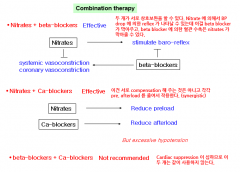![]()
![]()
![]()
Use LEFT and RIGHT arrow keys to navigate between flashcards;
Use UP and DOWN arrow keys to flip the card;
H to show hint;
A reads text to speech;
8 Cards in this Set
- Front
- Back
|
협심증 (Angina) |
Collat. circulation epi 쪽에만 존재 --> infarction이 endocardium 위주로 생긴다.
Angina Types: - Typical angina (due to atherosclerosis in coronary a) - Variant angina (due to spasm of coronary a)
- Unstable angina (with thrombotic, vulnerable plaque)
Angina Tx: -PTCA (percutaneous tramsluminal coronary angioplasty), coronary a bypass surgery |
|
|
Anti-anginal agents |
a. Organic Nitrates: reduce O2 demand >> inc coronary blood flow b. Calcium channel blocker: reduce O2 demand + inc coronary blood flow c. b-adrenergic blocker: reduce O2 demand |
|
|
Nitric Oxide (NO) |
-NO 는 endo 에서 NOS (Nitrogen Oxide Synthase) 라는 효소에 의해 형성된다. Smooth m. 에 diffusion 하면 cGMP 를 형성시킨다. -cGMP 가 올라가면 Ca 이 줄어들고, muscle contraction 에 관여하는 MLC를 탈인산화 시켜서 근 수축이 일어나지 못하게 해준다. -혈관 평활근을 이완시키면 혈압을 감소시킬 것이고 호흡계나 GI 혈압을 낮출 수도 있다. -cGMP 가 올라가면 혈소판 응집이 되지 않으므로 혈전치료에도 도움이 될 수 있다.
-Sildenafil 은 corpus cavernosum 에서의 cGMP 를 올려준다. PDE5 는 cGMP 를 파괴하는 효소인데 이걸 차단해줌으로써 cGMP 를 계속 유지시켜준다. -NO 는 cGMP 를 production 하는 것인데, sildenafil 에 의해 cGMP가 파괴가 안 되면 양이 증가할 것. 이 두 약물을 함께 복용하면 부작용이 발생할 수 있다.
**Mito.ALD 를 통해 Nitrate, Nitrite, SNP로부터 NO 가 형성된다. SNP는 spontaneous 하게 가수 분해 되어서 한 번에 NO 가 많이 나오게 된다. bulky vs. spontaneous production. |
|
|
Nitrates |
Nitroglycerin -Sublingual -Sublingual v --> SVC 통해서 심장으로 바로 들어감.
SNP -hypertension crisis에 사용. Angina에 사용 x.
Clinical Use: O2 demand 감소 (afterload/afterload 감소), O2 supply 증가 (wall tension 감소 + coronary a/v 확장).
Side Effect: a. S/D BP 감소 -저혈압 증상 -체위성 저혈압 -심장관류 감소 -O2 supply 감소 b. sympath reflex -동맥 수축, BP 증가 -심박동, 심수축 증가 -O2 demand 증가 c. renin 증가 -BP 증가 -fluid retention -O2 demand 증가 d. Perfusion 증가: skin flushing/headache
**Tolerance: 반복적으로 사용하면 Nitrate 효과 감소. -Tolerance due to inactivation of mit. ALD (enz damaged by NO-related reactive metabolites) + plasma expansion, baro reflex. |
|
|
Ca Channel Blockers |
Dihydropyridine group: nifedipine / others (a. smooth m. 에 작용) Non-dihydropyridine group: verapamil / ditiazem (심장에 작용)
Clinical Effect: (-) inotropic effect -> reduced O2 demand. (-) chronotropic effect: reduced O2 demand + inc. O2 supply Coronary vasodilation -> inc O2 supply
Systemic a vasodilation --> reduced afterload --> reduced O2 demand.
Toxicity: *Nifedipine: tachycardia due to sympathetic reflex *Verapamil/Ditiazem: bradycardia due to SA node depression. Thus NOT recommended comb. with b-adr. blockers |
|
|
Coronary Steal |
오히려 혈관을 확장시켰는데 ischemic zone의 혈류는 감소하는 게 coronary steal 이다.
"Worsening of angina by Ca-blocker dihydropyridines."
|
|
|
b-adrenergic blocker |
b1 selective: metoprolol, atenolol nonselective: propranolol, timolol
Toxicity: a. Variant Angina exacerbation due to a-adrenergic overshoot b. Congestive heart failure 악화 due to negative inotropic effect in acute phase. c. Conduction block. d. Bronchoconstriction e. Hypoglycemia
b-adrenergic blockers NOT for variant angina. |
|
|
Combination Therapy |

|

